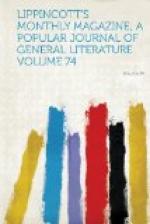The business of the ranch was the antediluvian occupation of rearing and shearing sheep, and to that end the village included a shearing-shed and a large wool-house. Besides these there were three cottages and several other buildings, among which one called the “ranch-house” was the focus of the activity of the place, and, being also a survival from a comparatively early day, was a somewhat characteristic affair. It was a box-house, painted red, with a broad porch thatched with bear-grass, and a saddle-shed butting up against it. The interior, barring a little store at one end, was a single large room, bedroom, sitting-room, office, furnished with home-made tables with blankets for cloths, knocked-up chairs with cowhide seats and coyote-skin backs, deers’ antlers draped with “slickers” (Texan for the ’longshoreman’s yellow water-proof) and wide-brimmed “ten-dollar” hats, and at one end two tiers of bunks, with leather cases for six-shooters nailed to their sides. This room served for the abode of the storekeeper, for the transaction of business, and for the accommodation of the perennial casual guest. It was rude, but, especially of evenings about the lamp, it had a marked air of pipe-and-tobacco comfort.
The little store was patronized by the cow-boy, so much abused with sensational or picturesque intentions, and by the small farmers with irrigation patches in the vicinity. It was likewise the resort of Encarnacion and Tomas, and others their brethren, from the Mexican village a few miles up the creek, or from isolated abiding-places round about. Here they would come, and, rolling cigarettes of the brown paper they affect and the eleemosynary tobacco open on the counter, to which all were welcome (such were the amenities of shopping on the ranch), they would lounge about, ever smiling and chattering in soft voices, finally to say ‘uenos dias with two bits’ worth of bacon, or corn-meal, or pink candy for the chiquitas. Here, too, would come Tomasa, and, with even more than usual feminine zeal in matters of dress, at once try on the ready-made calico gown she purchased, while the store-keeper smoked his pipe and stroked his beard.
Excepting the cow-boys, the people composing the clientage of the store were for the most part resident in one of two farm-settlements located on the creek, about ten miles apart, one exclusively Mexican, the other almost entirely “white.” Besides these, the families of many of the Mexican hands lived close by. These last were constantly assisting conversation at the cottages with such incidents as the following:
The cook—a tall, gaunt negro of a mediaevally “intense” nature—came in with an excited manner, followed by Madame Alguin, very much troubled, wringing her hands, and dissolved in tears.
“Panchot’s little boy,” said the cook, “is killed.”
We were naturally aghast. Little Panchot had been colero at the recent shearing.




